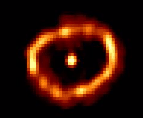V1974 Cyg (Nova Cygni 1992)
 |
| A 1994 Hubble Space Telescope image of the expanding shell of gas expelled by Nova Cygni 1992. Credit: NASA, ESA, HST, F. Paresce, R. Jedrzejewski (STScI) |
On the night of 1992 February 18-19, through a moon-lit sky and polluted conditions due to a recent volcano eruption, Peter Collins of Boulder, Colorado, USA, visually spotted a suspect object shining at magnitude 7.2 at a location about 6 degrees north of the bright star Deneb. After comparing the location with an atlas, he decided that perhaps it was nothing new, but would check additional references later to be sure. Before making the comparison, Collins observed the field again and found that within 9 hours the suspect had brightened by an additional magnitude! After checking various catalogues to no avail, Collins contacted AAVSO Headquarters and various other authorities so that the astronomical community could be alerted about his finding (Alert Notices 155, 156). For his visual discovery, Mr. Collins was awarded the AAVSO Nova Award, presented at the 1993 Spring Meeting of the AAVSO held in Berkeley, California, USA.
 |
| Visual light curve of V1974 Cyg from the AAVSO International Database; August 31, 1991 to August 13, 2002. |
Within days of its discovery, the nova brightened even further, reaching a visual maximum of 4.3. Not only was V1974 Cyg observed in the optical portion of the spectrum, but it was also well monitored throughout the entire electromagnetic spectrum. The International Ultraviolet Explorer (IUE) satellite began observing the nova only 15 hours after the discovery report. In fact, V1974 Cyg is the first nova to have been observed throughout the entire regime of wavelengths and from many points of view, including from the ground, the air, Earth's orbit, and beyond. As a result, V1974 Cyg is one of the best studied novae overall, and remains the best studied neon novae (Bode 2011). It was the first nova observed in outburst by the Hubble Space Telescope (HST), EUVE, Voyager, and CGRO. As well, it was monitored by the Roentgen X-ray Satellite (ROSAT) and the Kuiper Airborne Observatory (KAO). AAVSO observers aided in these studies by providing observations around the time of a September 8, 1992 MultiWaveLink network campaign (Alert Notice 162). To date, nearly 110,000 observations of V1974 Cyg are contained within the AAVSO International Database.
Having pre-maximum data is somewhat rare since most nova discoveries are made after the nova has reached its greatest brightness. In addition, the full-spectrum coverage of the event also set this nova apart from its kin. Finally, the imaging of the nova with HST in 1993 provided the closest look at the expanding shell and conditions very early after the initial event. Through observations from HST, IUE, and ground-based optical and radio telescopes, it has been seen that the shell was not ejected symmetrically but rather in many pieces. In addition to a thin, fast-moving outer cloud there was a slower, higher mass inner debris field made up of an equatorial ring (probably aligned to the orbital plane of the binary system) that had knots of brighter material embedded in it. Chemical analysis of these knots done via spectroscopy showed that this material was different from that seen on the white dwarf itself. This is important because future observations of this phenomenon in other novae may lead to models of how the material that a white dwarf collects from its companion mixes with the white dwarf material itself before the nova outburst occurs (Bode 2011).
Having this richness of data meant that over the next decade astronomers could test their models of nova evolution across many wavelengths, by comparing actual and theoretical multi-wavelength light curves. These in turn could be used to determine the intricate interplay between the white dwarf and its companion, and with the general environment in which both were embedded. For example, astronomers determined that the white dwarf had a mass of just slightly more than our sun and surmised its composition to be less than half hydrogen (by mass) and 5% neon (Hachisu and Kato, 2005). The X-ray and optical light curves were used to determine the rate at which hydrogen shell burning occurred, and the optical, infrared, and X-ray data allowed astronomers to determine how the white dwarf’s intense stellar wind interacted with the companion star (Hachisu and Kato, 2005). The observed scattering of the X-rays also allowed astronomers to test models of interstellar dust; the technique proved so promising that researchers suggested that X-ray observations be done of objects outside the Milky Way to further constrain various models of interstellar dust (Draine and Tan, 2003).Therefore this nova has rightfully earned its place in the history of variable stars.
Bode, M.F. “The Outburst of Classical and Recurrent Novae.” AN 331.2, 160-8, 2011.
Draine, B.T. and Tan, J.C. “The Scattered X-ray Halo Around Nova Cygni 1992: Testing a Model for Interstellar Dust”, AJ 594, 347-62, 2003.
Hachisu, I. and Kato, M. “Toward a Unified Light Curve Model for Multi-wavelength Observations of V1974 Cygni (Nova Cygni 1992)”, ApJ, 631, 1094-9, 2005.

